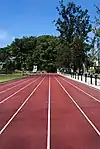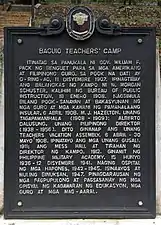Teacher's Camp
The Baguio Teachers' Camp (BTC),[1][2] sometimes referred as Teacher's Camp is an events venue and teachers' training center located along Leonard Wood Road in Baguio, Philippines.
| Baguio Teachers' Camp | |
|---|---|
 | |
| Location | |

| |
Philippines | |
| Coordinates | 16.41222°N 120.60806°E |
| Information | |
| Type | Vocational, Normal |
| Established | December 11, 1907 |
History

It was established on December 11, 1908 by an ordinance by Benguet Governor William Pack in an area which was then named O-ring-ao to accommodate both American and Filipino teachers. The outline of the camp's plan was made by W. Morgan Schuster, secretary of the Bureau of Public Instruction on January 18, 1908.[3]
The camp opened as a training center and vacation site for teachers and employees of the Insular government a few months later on April 6, 1908. The first Teachers Vacation Assembly took place from April 6 to May 30, 1908.[3] During its early years, tents were used for the camp's classrooms, kitchen, dining and storage facilities.[4]
In 1911, the first building was built in Teacher's Camp.[3] Access roads and pathways were made. In 1912, cottages were set up for the camp director, secretary and undersecretary of education. More funds were allocated for Teacher's Camp's development which led to the Benitez Hall, Ladies Hall, Teacher's Hall, Tavera Hall, and the White Hall being built.[4]
The Philippine Military Academy (PMA) previously occupied a large area of Teacher's Camp before World War II from 1936. The PMA temporarily moved out of Camp Henry Allen to Teacher's Camp on due to a projected increase in the number of members of the Cadet Corps. During the PMA occupancy the General Luna Hall was built.[4] The PMA stayed in Teacher's Camp from June 15, 1936 until December 12, 1941,[3] when the world war broke out. After the war the academy moved backed to Camp Allen in 1947. It transferred to Fort Gregorio del Pilar in 1950.[5]
During the Japanese occupation of the Philippines from 1942 to 1945, the occupying forces use the camp as their hospital. It was left damaged after the war but was repaired and reopened in 1947.[3]
The first Philippine Sports Summit was held in the early 1990s during the presidency of Fidel V. Ramos where the Magna Carta for Philippine Sports was made as an effort to boost the national sports program. Such efforts failed when the original Magna Carta was not referred to in the succeeding summits.[6]
Usage

Teacher's Camp served as a training center for teachers from various parts of the Philippines. Teachers enroll in education special courses during the summer break. The center hosts classrooms, dormitories, cottages, dining areas, assembly halls and administrative offices. When teachers are not using the facility, the dormitories and cottages are rented to tourists. It also hosts events sponsored by government agencies.[4]
It also has an athletic oval where national athletes of the country who compete in the Olympics trains.[4] From 1976 to 1989, track and field athletes under the government initiated, Gintong Alay sports program trained at Teacher's Camp.[7]
Heritage status
On May 12, 2008, Teacher's Camp was reportedly declared as national heritage site.[2] The facility is a marked structure according to a 2015 report.[8]
Believers of the paranormal say the camp is haunted because it is claimed to be more than 100 years old.[9][10]
References
- "DepEd Memorandum No. 236, s 2008: Baguio Teachers' Camp: Celebrating 100 Years of Educating the Nation" (PDF). Department of Education. 6 May 2008. Retrieved 13 June 2017.
- "Feature: Baguio Teachers Camp revels in its centennial". Philippine Information Agency. 12 May 2008. Retrieved 13 June 2017.
- Baguio Teachers' Camp (Marker) (in Filipino). Baguio Teachers' Camp grounds: Philippine National Historical Institute. 2008.
- "Teacher's Camp". City of Pines. Retrieved 13 June 2017.
- Bueza, Michael (14 March 2014). "FAST FACTS: The Philippine Military Academy". Rappler. Retrieved 13 June 2017.
- Velasco, Bill (29 August 2016). "Master plan". The Philippine Star. Retrieved 13 June 2017.
- Dee, Ignacio (18 November 2014). "The bells toll for the Rizal Memorial". Rappler. Retrieved 13 June 2017.
- See, Dexter (19 May 2015). "NHCP letter merely an advise – NCCA". Herald Express. Retrieved 13 June 2017.
- Vince (23 October 2014). "Five Haunted Places In Baguio City". LakbayBaguio. Retrieved 12 December 2016.
- Palma, Renzelle Ann (23 October 2013). "Top 5 Baguio Haunted Spots". Choose Philippines. Find. Discover. Share. ABS-CBN Corporation. Retrieved 12 December 2016.
